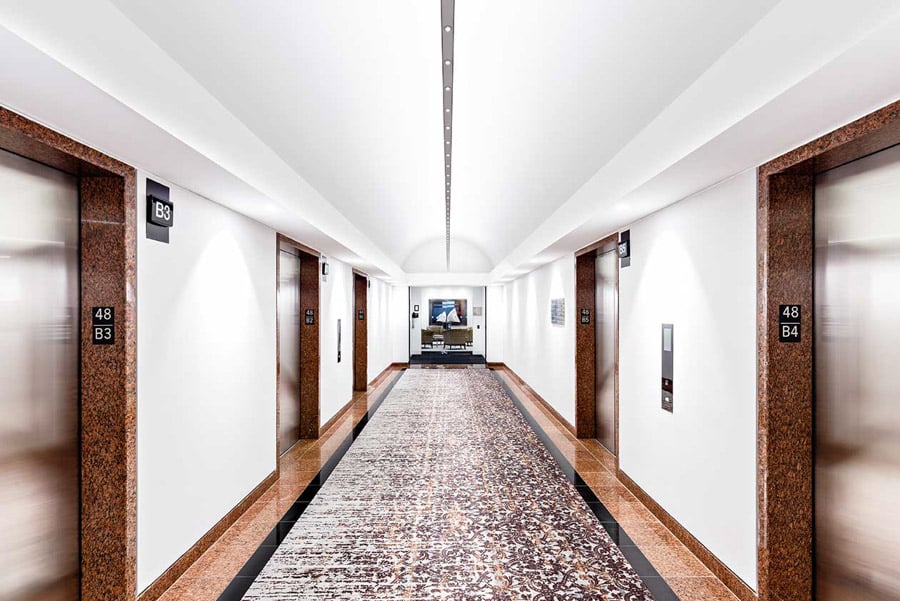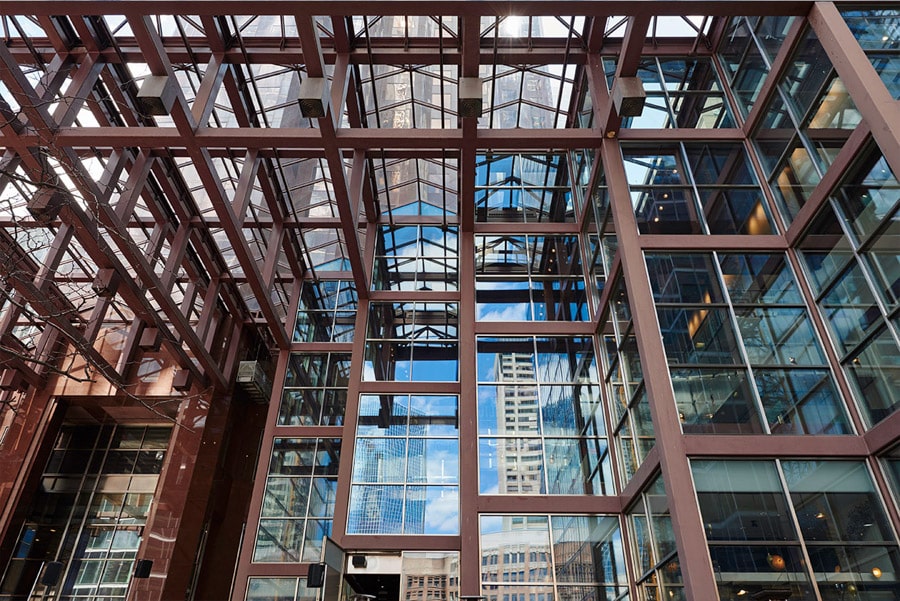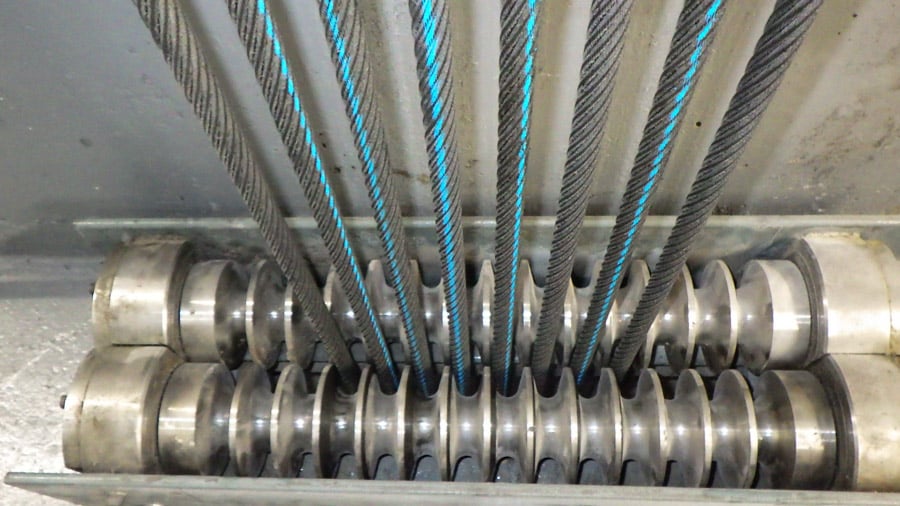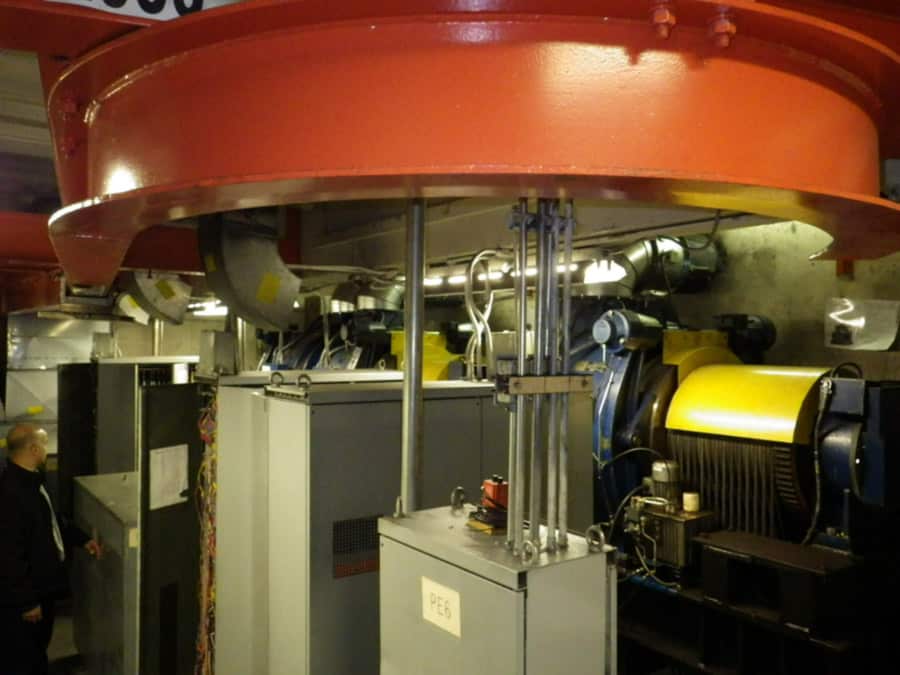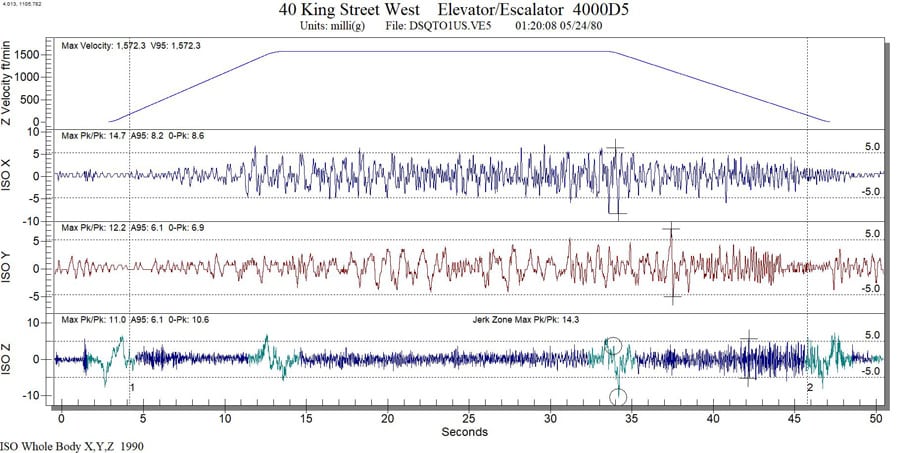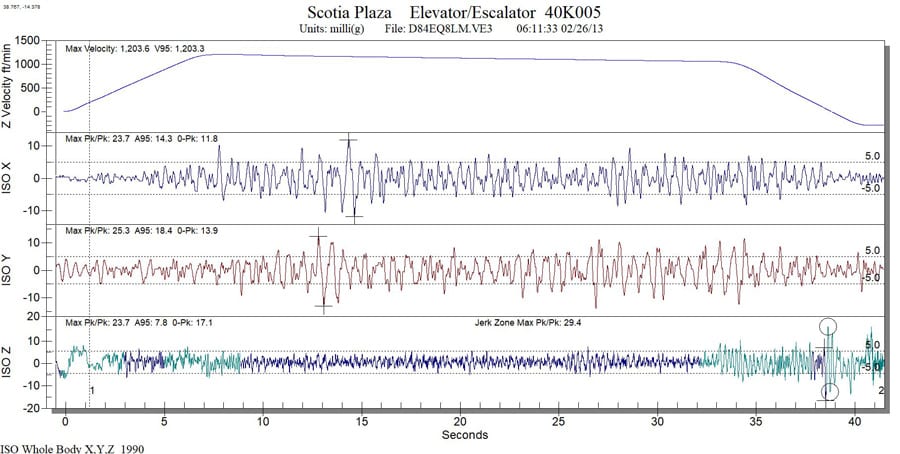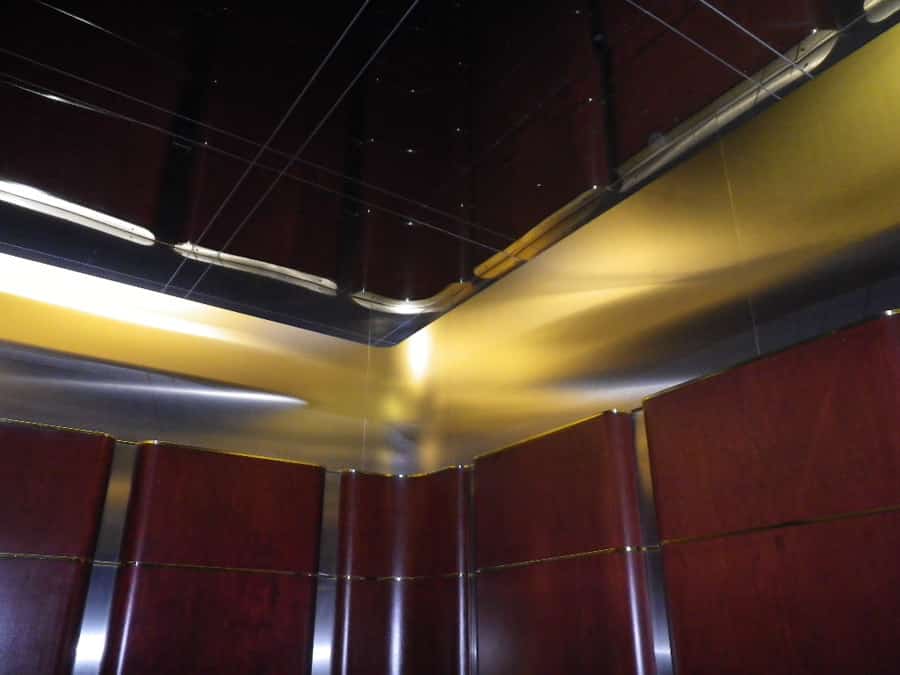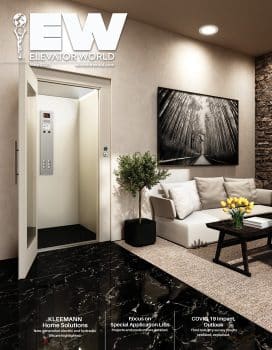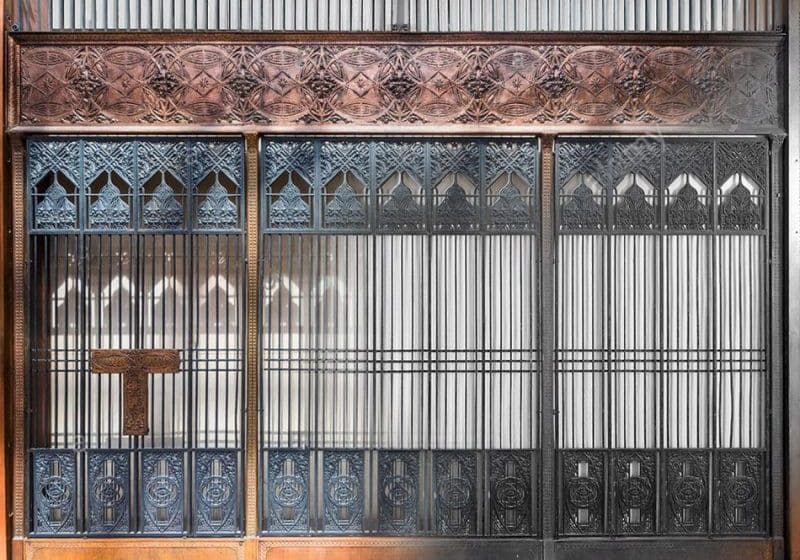Your author reflects on a challenging-yet-rewarding modernization project in downtown Toronto.
All consultants bring a vastly different set of expertise and experience to their work. When you complete a vertical-transportation (VT) modernization specification without a hitch in the midst of a property ownership upheaval that undergoes peer review by four other consultants, you have done well. This was the case with Scotia Plaza in downtown Toronto.
At 40 King Street West, Scotia Plaza is Canada’s third-tallest skyscraper and the 22nd-tallest building in North America. The building was constructed in the late 1980s. Standing 275 m, the tower is served by two service elevators and 22 double-deck elevators in four banks: five high-rise elevators serving the concourse, ground and 55th-68th floors; five mid-high-rise elevators serving the concourse, ground and 41st-54th floors; six mid-low rise elevators serving the concourse, ground and 23rd-40th floors; and six low rise elevators serving the concourse, ground, and floors 3 and 5-22.
Each cab has 1350-kg capacity with a double-deck total capacity of 2727 kg per elevator shaft. This 69-story tower is one of a small number worldwide that employs double-deck elevator technology using DC gearless machines. Schindler installed the original Miconic V 12 Pulse Drive equipment.
The modernization consisted of the 22 double-deck tower cars, two high-rise service elevators, three parking shuttles, one low-rise shuttle, two inverted gearless machines installed on the ceiling and a low-rise service elevator. When the modernization started in 2013, we believe it was the largest single such modernization in North America in terms of cost and scope. It was completed in April 2021.
This modernization was significantly different from the hundreds of others my firm had done. First, it took about six months to put together — not because it was difficult, but because of the time required to ensure all its different parts worked together to produce a uniform vision. It was not good enough to provide a performance specification and hope for the best. The payoff to our hard work was less than 2% in change orders. Thankfully, no costs were associated with a missed or unclear scope.
I still remember my Design Engineering professor talking about how engineering is a fragile balance between cost and usability (that a product does what it promises). This lesson stuck with me, because there are many overengineered (yet good) products that never saw the light of day. The first step to tackling this modernization was determining what needed to be fixed, maintained and changed.
At the time of the project, Scotia Plaza had a reputation for poor elevator service due to the age of the equipment (35 years) and inherent issues with the old Schindler equipment. I am pleased to report that the new elevator system remains solid. I would be happy to put it up against any in the country. I say this with conviction and proof. The callback ratio on these elevators is less than 0.25 per elevator, counting double decks as one elevator, every four months. If we count the elevators as upper and lower decks, this ratio goes down even further. This is the story of how we achieved the client’s goals and how Schindler awarded the modernization contract that got us there.
Pieces of the Puzzle
Traffic Analysis
The first step in the design was to complete a thorough building traffic analysis to determine what was needed to achieve reasonable wait times and performance. This process required a significant number of simulations and tweaks to the elevator system to determine what would likely improve its performance. We determined that improving speeds would be beneficial for wait times and that door speed would play a critical role.
Door-close times cannot be tweaked too much, as this might cause incidents with door contact. So, focusing on door-open times was an easy route, provided we could get the door operators to achieve the desired times. The elevator speeds would take advantage of the express zones, while door-open times would permit passengers to vacate the elevators quicker. The challenge with sub-1-s door-open time for a 1,117.6-mm-wide door was a huge undertaking. Also, the increase in speed was not easy to achieve, because we had to consider that the clearances needed under ASME A17.1-2010/CSA B44-10 were, in some cases, not possible.
Machines
For a few reasons, specifications called for new active current permanent-magnet (PM) machines. The first was that we wanted to change the existing machine due to its design not being suitable for the site. The old machines were obsolete, with possible sheave separation, short-rope-life issues and excess carbon contamination. The second was the need to increase speed. The DC machines ran at 209 rpm, which was fast, and, given the carbon softness needed for good computation, the machine room was often covered in carbon dust. Part of the challenge of replacing the machines was that the machine rooms did not allow for armature maintenance or machine replacement. The floors of the tower would not allow the machines to be rolled.
In the early 1990s, Schindler devised a rail solution to ferry the suspended armatures to the service elevators. The I-beam rails used for transportation were bolted to the building via a system that had to be assembled at night and disassembled in the wee hours of the morning so that building operation would not be disrupted.
Think of this as a suspended I-beam ‘road’ that is hung on the walls of the building above the corridors. The I-beams would be connected in sections until they create a path to the service cars. The service cars had to be programmed and counterbalanced to accept the weight of the armature, as the capacity of the service elevators — 2500 kg — was not sufficient to carry the weight of the armatures.
This added a lot of cost. Devising a solution around it would be pivotal to a bidder’s success. PM motors are not modular, which makes transporting them very difficult, as the floors are not designed to handle the load. Schindler’s AC induction motors are modular, which eliminated the need for building disruption, as most of the components came in pieces and could be assembled onsite. This was a huge bonus, as it eliminated the need for the heavy railing system.
I contend that machine rooms should be designed for maintenance access. Consultants and contractors should always consider access in new construction sites. We have noticed on many construction sites that this is not a consideration. However, we believe it is essential for good building design.
Car Speeds
Car speeds were reviewed from a traffic-handling point of view. We focused on increasing the speed without the effects of diminishing returns. We had to balance what could be retained versus what had to be replaced to achieve the best value. To achieve the desired speed, we would have to provide a deeper pit and new safeties, governors, buffers, pit equipment and electrical service. This was opposed to a compromise that would provide similar performance but with more equipment retained.
The difference in performance between 9 and 8 m/s was not significant enough to justify the incredible cost. The benefits were marginal compared to the benefit of reducing the door-open time from 1.5 to 1 s. So, we designed the high rise and mid high rise with an 8-m/s objective.
As one would expect, there were challenges — as well as significant costs — associated with increasing car speeds. At the proposed speed of 1,600 ft/min, the dual car safeties were retained, as they satisfied the engineered requirements for elevators. Structurally, the overall impact to the building did not change. Hence, the decision was relatively simple as the increased speed improved the system’s traffic-handling capability by taking advantage of the express zone. As far as clearances were concerned, the site was using reduced-stroke buffers, so it was not much of a challenge to continue with this strategy.
Door Operators
When it comes to door operators, I believe the Otis HPLIM is the fastest and quietest door operator ever conceived. The HPLIM uses a linear-induction-technology door operator. The system streamlines operation by attaching the motor armature to the door and moving it laterally along a copper plate mounted above the door frame. This reduces the number of moving parts, resulting in smoother, more dependable operation. The system’s closed-loop software maintains the same profile regardless of environmental conditions. However, at an estimated 158 kg, this door operator is heavy. It is also power hungry. So, a similar system that could have two door operators individually running one center-parting door each would be ideal.
We met with GAL Manufacturing Corp. representatives and asked if they could provide a door operator capable of opening the 1117.6-mm doors at a speed greater than 1 s. GAL offers the powerful MOVFE-2500 linear-induction-technology door operator. Having two of these working together to achieve an open-door time per door panel of less than 1 s would have provided us with a quick solution.
GAL designed a synchronization board to ensure one signal was directed to both operators. The synchronization board also communicated to the controller to remove the car from service (once the cabs were vacant) in the event of a door operator malfunction. After testing and tweaking, GAL introduced the MOVFE-3000 capable of consistently opening the 1117.6-mm doors in less than 1 s. From a traffic-handling point of view, the upside of this door operator is significant. At that speed, stationary mechanical restrictors were specified to avoid the “clunk” associated with the restrictor roller engaging and releasing the clutch.
The difference in performance between 9 and 8 m/s was not significant enough to justify the incredible cost.
The advantage of a 1-s door-open time in a high-rise class-A office building is very beneficial. For example, a nine-story building with four elevators and 680 persons (85 per landing) can have an average wait time of 41.9 s with a door-open time of 2.3 s. With all other settings unchanged, we can reduce the door-open time to 1 s and improve the average wait time to 26.4 s. That represents the transformation of a building with a flawed elevator-handling system to one with top-notch elevator performance.
Unfortunately, the door operators were abandoned halfway through the project to reduce the schedule by roughly two weeks per car. The GAL MOVFE-3000 is still being installed in a few Toronto sites where traffic analyses suggest an improvement is needed in door-open time.
Equipment Removal
The design of the building did not allow any floor loading over 150 lb per ft2. Therefore, the major components had to be broken down into smaller pieces to maneuver through the corridors. A greater challenge was bringing in the new Schindler 710s machines. They are modular, but special equipment had to be designed to transport new and old equipment to ensure maximum floor loads were not exceeded.
Instead of breaking the gearless machines from the site, Schindler decided to cut them down, which allowed control of the weight and size of the sections. Using a torch was not ideal, given the small size of the machine rooms and subsequent possibility of fire hazards (as nearly all levels of the building were occupied). To remove the existing armatures, they needed to be cut in half using an E.H. WACHS® DynaPrep MDSF Split Frame portable cutting tool. This device cuts completely around the circumference to within 4 in. of a complete cut. The final piece can then be cut with a guillotine-type device. For this application, the sheer weight of the existing armature was able to sever the final section.
Two-Way Communication
Two-way communication was also very complex, as we had a many elevator cabs operating on audio and video feeds. In the event of an entrapment, the site utilized two-way communication with audio and video feedback. The old system utilized an analog video system (similar to Skype) in the elevator cab above the drop ceiling. The computer used Wi-Fi installed in the elevator shafts. The camera and microphones were then connected to the computer, which dialed the security center and allowed the media screen to project the security guards inside the cab. By today’s standards, the old system was not remarkable, but, at the time, it was groundbreaking.
Another design challenge was double-deck fire-service operation. Firefighters’-Emergency Operation Phase II is on the upper deck. To close the door on the lower deck in Phase II, the previous solution utilized a toggle switch on the lower deck: a person would have to enter the lower-deck cab, toggle a door-close switch, then step out of the cab to allow the door to close on Phase I recall. Then, a person would have to go to the upper deck to operate Phase II fire recall. This approach was time-consuming and, in case of an emergency, inefficient.
Webb Electronics provided a mock system using CE Electronics (CEE) screens. The system was reviewed with the client and adopted. The elevator cabs utilized CEE ELITE PI 15” to allow for messages (serving the lower cab, emergency messages and phone system). I believe CEE products are well known, supported and do not become obsolete every two s. However, its analog system posed a challenge when it was deployed. At the time, CEE did not have a digital port to deal with the camera inputs. However, it addressed this issue with a digital solution that worked.
Ride Quality
At 2727 kg per car, roller guides were needed to improve ride quality without using active dampening. Few elevator contractors had a system that met this requirement. We looked at possibly using roller guides that could mitigate the need to align rails. (Scotia Plaza is a tall, slim building. As such, it is susceptible to twisting and bending.) However, we could not find any commercially available rollers that could achieve rail alignment. ELSCO’s Express 6 roller guides were tested, but the rails were too out of alignment.
Wind Mitigation/Sway/Harmonics
Wind gusts play a factor in building characteristics at Scotia Plaza. This can have a negative effect on the elevators, as the ropes oscillate and, at high speeds, can become intertwined and snap. Generally, what happens in this situation is a rush to slow the elevators to half speed to prevent incidents. In our case, the building was outfitted with a wind and gust monitor that feeds the elevator system. Based on gust and speed, the system feeds the elevator controller to slow the system based on three speed criteria. Unfortunately, there is no hard data for wind gust and speed that ties directly to building sway. A study could be done, but the problem with it would be the sensor needing to know wind speed, direction and gust, then correlate it to sway.
Instead of breaking down the gearless machines from the site, Schindler decided to cut them down for controlled removal.
When measuring wind data, every building around Scotia Plaza will have an impact on wind direction and speed. Skyscrapers play an important role in casting shadows on the streets, wind direction and wind speed. Every time a new building goes up, any previous wind study becomes obsolete because every new structure — regardless of proximity — will have some impact in slowing or increasing wind gusts.
To protect riders, we specified a seismic switch that could detect earthquakes. This was surprisingly controversial, as a peer reviewer thought we were changing the guide rails and upgrading the elevators to earthquake zone. In fact, we were not. We just specified the sensor to pick up unusual tremors or violent shakes to protect the public, especially given the elevators’ speed.
We also specified a hydraulic-based piston to add pressure/force to the compensating sheave to alter the harmonic frequencies of the ropes by adding force dynamically. A study was undertaken by Schindler to ensure the elevators could not stop in an area of the shaft where the ropes would be susceptible to harmonics in lieu of adding weights, as the company did not have the capability to do that. Finally, a cowling system was specified to address the increase in speed and improve ride quality, along with new roller guides to improve passenger comfort and ride experience.
Bearing Monitors
We reached out to SKF to design a bearing monitor for the new elevator system. The system would consist of a programable logic controller that would take the bearing frequency at high speed and then determine if the bearing required any lubrication or replacement. It would also measure the operating frequency to determine if the bearing was reaching the end of its useful life. The system is simple to implement, provided the controllers can provide a signal when the bearing is running at high speed. This is key if you plan to install a bearing monitor, as high-speed operation is the best way to measure bearing frequencies for potential failure. As mentioned, this solution was rejected by one of the stakeholders and removed from the scope.
Peer Review
So, back to our consultant friends who were promising our client a 50% reduction in cost and shorter schedule. As you can see from the scope of work, it was impossible to keep the machines due to carbon dust, and traffic analysis and change-in-speed requirements.
We argued the review was biased and should not be considered, because the party reviewing the specifications lobbied for the job before we were awarded it. We argued the machines could not be retained and would be detrimental to the modernization and that the speed change would necessitate this requirement. Our arguments were considered by some (but not all) stakeholders as the reviewing consultant argued we were simply wrong. What was unsettling for me was the raw fearmongering and falsehoods perpetrated by our competition in an effort to take the job. They argued that the increase in speed would have people convulsing in the elevators and referenced the Pan-Am building experiment with Westinghouse in the 1970s. They said humans cannot undergo a speed change of 8 or 9 m/s, as their bodies are not equipped for it without a pressurized cab.
What was unsettling for me was the raw fearmongering and falsehoods perpetrated by our competition in an effort to take the job.
Finally, in a meeting with the two finalist proponents, the ownership reached out to both bidders and asked if they would consider retaining the machines. Both bidders said they would withdraw their proposals if this had to be the case. In that instance, we were vindicated, and our competitor, who was present during this meeting, just fluffed it off as, “OK, so we have to retain the machines,” as if nothing had happened.
The competing consultant who was trying to ‘steal’ the job was lobbying that replacing the machines was not necessary and that many jobs have gearless machines that are retained. Without knowledge of the issues, and speaking off the cuff, the competing consultant was completely embarrassed, because the foundation of his argument was flawed. Even if you ignore the reasons (speed and performance) for needing to replace the machines, you cannot ignore the fact the competitor was badly mistaken. Had he won the lobbying effort and gotten us fired, he would not have succeeded in delivering the promised goods.
The finalists then convinced one stakeholder group to review pricing. They would provide a complete breakdown of the cost to determine where they could negotiate price. They were awarded work to review a price to determine if it were correct. In disbelief, I urged the stakeholder to stop this process, as it is futile to argue a price in a tender. That’s because parts and labor costs are not the only factors that go into producing a price. There are many elements — including depth of management on a site of this magnitude, size of the machines needed, repair of existing equipment and engineering the dispatching system. Schindler’s roller guides are much more expensive than ones provided by ELSCO, for example.
In this case, we had a price from the only two legitimate bidders. How are you going to argue this point? You can negotiate a lower price but not by telling the bidders their cost is wrong. After all, on a job this size, the price would have been vetted twice or three times and, in some cases, independently priced by two teams from the same company to make sure there were no mistakes.
Finally, to alleviate the various nonsensical opinions, the client agreed to put all the consultants in a room and asked them to provide an opinion on what should stay and what should go. In the meeting, all three consultants agreed the scope was good and that there should be no changes other than removal of the bearing monitors. So, the bearing monitors were removed from the scope. I was sad, but not surprised, to see that aspect of the modernization go. Usually, maintenance improvements are the first things to go in modernizations.
Get more of Elevator World. Sign up for our free e-newsletter.



